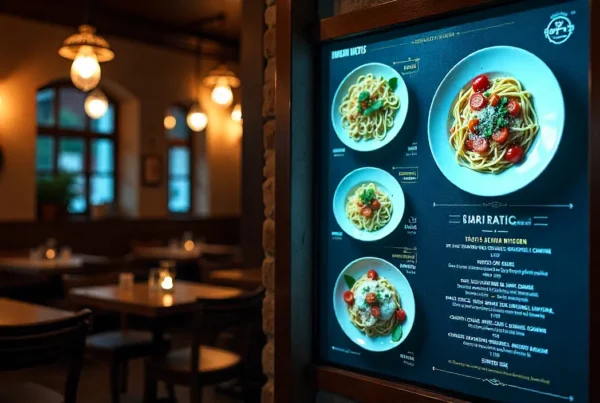Dynamic digital signage combines modern screens with smart platforms to create messages that change with time, place, and audience in the always-on world. These networks are unlike static posters because they are driven by cloud tools and data to drive updates in seconds, personalize experiences, and measure what works. Whether it is retail and corporate or transport and healthcare, dynamic digital signage solutions are now the quickest to on-brand, real-time communication.
What Is Dynamic Digital Signage?
Dynamic digital signage is an interactive and automatically updated network of screens that display real-time content. Digital signage software solutions organize the assets, schedules, and devices under the hood to get the right message to the right moment, whether that is one display or thousands.
Core Components
A powerful combination incorporates digital signage screens (LED, LCD, or touch), dynamic digital signage software to manage content, and cloud-based digital signage to manage all remotely. Add interactive digital signage (touch, QR, sensors) to convert attention into action and feedback loops you can tune.
How It Works
Teams create visuals, videos, and widgets, then use software for digital signage to tag, schedule, and target playlists. The deployment is a centralized digital signage system that publishes content to players with media recorded on each device, providing an efficient playback experience. Real-time updates will enable you to edit the creative in real time without compromising brand governance and uptime.
Why It’s Different
Static signs do not change. Dynamic networks distribute digital signage dynamic content that includes live data, dayparted menus, localized pricing, and event-driven alerts, so screens remain useful and relevant. It is this agility that boosts engagement, conversion, and the ROI of the entire campaign.

Benefits That Move the Needle
Real-Time Content Updates
Using dynamic digital signage software, teams exchange promotions, notices, and emergency alerts between one location or a worldwide fleet within seconds. The elimination of print runs frees up lead time in the campaign and operational friction.
Engagement & Interactivity
Touch, gesture, and mobile handoffs (QR/NFC) enabled by interactive digital signage transform passive viewing into guided discovery and self-service. This two-way experience prolongs the stay and provides measurable outcomes like product taps or route-finding decisions.
Cost & Operations
Reprint, shipping, and in-store labor costs are cut through centralized control. Approval and templates enable marketing to work quickly without skipping brand specifications, and device health monitoring eliminates unnecessary truck rolls.
Brand Perception
A contemporary, technology-savvy brand is introduced by motion graphics, sharp typography, and calibrated digital signage displays. Credibility is enhanced through standardization, and messages are relevant due to local differentiation.
Analytics & Optimization
Most digital signage software applications have proof-of-play, dwell, and interaction logs. You will be able to test creatively, optimize targeting, and connect results to store KPIs (traffic, conversion, and basket size).
Market Trends in 2025
Cloud-First Deployment
Speed, scalability, and reduced on-site complexity are encouraging most new rollouts to standardize on cloud-based digital signage. Fleet dashboards aggregate monitoring, updates, and role-based access.
AI-Driven Personalization
Dynamic content is context-specific, tailored by models to time, weather, inventory, or audience cues, so that each loop feels timely and specific. Smart suggestions and automatic dayparting can be expected.
Interactivity at Scale
Touch, gesture, and voice interfaces are mainstream, particularly for wayfinding, menus, and self-service kiosks. With the maturity of UX, interactive digital signage will lead to quicker decisions with minimal staff interventions.
Cross-Industry Momentum
Retail has dynamic pricing and promo loops; healthcare informs and queues; corporate leaders broadcast; transportation has real-time schedules and alerts. The digital signage market is a dynamic one that keeps compounding, as the results can be measured easily.
Choosing the Right Dynamic Digital Signage Software
Cloud vs. On-Prem
Cloud is easier to deploy and maintain, and on-prem is suitable for strict networks or custom integrations. Other businesses combine the two in resilience and control of regions.
Content & Workflow Features
Seek drag-and-drop layout, multi-zone canvases, versioning, approvals, and fine-grained scheduling. These features guarantee high-paced teams with no compromise to governance.
Screen & Compatibility
4K, portrait/landscape, video walls, and touch confirmation. Test EDID processing and playback of high-bitrate media to keep the digital signage displays crisp.
Interactivity & Peripherals
When kiosks are important, make sure the touch, printers, scanners, and payment systems are first-class. Digital signage will have mature software that exposes APIs and webhooks to facilitate the orchestration of devices.
Security & Governance
Secure boot, encrypted comms, SSO, and audit logs will be on your wish list. Remote diagnostics and lockdown modes ensure uptime and brand integrity.
Analytics & Proof-of-Play
Embedded dashboards must report uptime, playback, and interactions, and logs must be exportable to ensure compliance and campaign attribution.
A lot of customers are looking up “digital signage software.” Practically, you are choosing a platform: an editor, a scheduler, a device manager, and analytics combined.
Provider Landscape: Who Fits Where
BrightSign has dependable hardware and strict scheduling; ScreenCloud has a focus on simplicity with cloud-first teams; Yodeck has a low-cost SaaS; Nento has a user-friendly editor; Scala has high-end enterprise requirements. Do not pursue the longest list of features, but instead match vendor strengths to your content weight, compliance posture, and rollout timeline.

From Pilot to Scale
Begin modestly: with a single store, lobby, or campus building. Put in place metrics of success and stress-test your playlists under network conditions and devices. As soon as the pilot is proven out, standardize templates, codify approvals, and roll out to additional sites with a clear content calendar. This practice de-risks implementation, and it maintains the pace of dynamic digital signage implementation.
Make Every Screen Dynamic
Tell us your locations, content types, and timelines, and we will plot the quickest route between the pilot and the multi-site network. Starting with cloud tools or dedicated players, we will assist in designing templates, automating dayparting, and keeping screens fresh with on-brand dynamic digital signage that will lift engagement and lower operational noise.
Turn Your Screens into Results
Share your locations, content mix, and goals, and we’ll map the fastest path from pilot to scale—whether that’s cloud-based digital signage for easy control or kiosk-ready templates powered by dynamic digital signage software. In a rapidly maturing dynamic digital signage market, we’ll help you standardize layouts, automate dayparting, and keep every display on-brand.
Ready to upgrade? Let’s plan an MVP, validate impact, and expand with confidence using dynamic digital signage across your sites.
FAQs: Dynamic Digital Signage
What is dynamic digital signage?
It is a screen network that displays real-time interactive content, which is controlled by dynamic digital signage software. A central dashboard controls schedules, targeting, and device health.
How does cloud-based digital signage work?
Assets are in the cloud; you control playlists remotely. Content is cached by the players to play back smoothly, and screens continue to run even when the connection goes dead—characteristics of cloud-based digital signage done right.
Which industries benefit most from digital signage solutions?
Digital signage solutions are used in retail, healthcare, education, transportation, hospitality, and corporate communications to ensure messages are timely and relevant and that results are measurable.
Can it be interactive?
Yes. Interactive digital signage is touch-friendly, gesture-friendly, and mobile-friendly (QR/NFC). It is perfect for wayfinding, product discovery, and self-service.
Static vs. dynamic—what’s the difference?
Static content remains the same. Digital signage dynamic content is run on dynamic networks, which include videos, live feeds, data widgets, and targeted offers, and updates automatically by triggers or rules.
What features should digital signage software solutions include?
Seek out remote device management, drag-and-drop layout, multi-screen support, integrations, analytics, and user roles. These dictate day-to-day usability on a scale.
How much does a digital signage system cost?
Prices depend on the type of display, licensing, and installation. Basic SaaS can begin at a small monthly subscription, but enterprise packages with SLAs and integrations are more expensive. Your digital signage solution must be proportionate to your size and regulatory requirements.
Can it integrate with social media or data feeds?
Yes. Layouts on most platforms can be streamed with social posts, POS data, weather, or inventory to ensure that the content is current without manual intervention.
What’s next for digital signage displays?
There will be more efficient panels, improved color fidelity, and easier mounting. When paired with 5G and edge computing, digital signage displays will support richer media with reduced latency.





